Check out the SIG P320: http://www.sigsauer.com/CatalogProductDetails/p320-full.aspx
When the SIG SAUER P320 was introduced, it was met with cautious optimism. After all, the P250 platform that first introduced the polymer framed, modular component concept at SIG didn’t exactly set the world on fire. But then few innovations really do take off on their first flight. The Wright brothers made several piles of scrap in their field before making history. The P320 is a striker-fired, rather than hammer-fired platform that uses an internal chassis or fire control group as the serialized gun (SIG calls this the “frame” to make things really confusing) – everything else is just “parts” and not a firearm. If this is all old news to you, then you’ve seen it before. The P320 series has been out for a while now – about a year. But not in .45 ACP – until now. Initially expected in the early spring of 2015, it has been slow in coming for those of us who love the P320 and love 230 grain projectiles.
I do admit without shame that I am a fan of the Sig Sauer P320. The consistency of the platform is very impressive, as is the ability to quickly re-purpose your firearm from a subcompact 9mm to a full sized .40 or .357 Sig in mere seconds. It’s like Transformers for gun geeks! But I remember thinking, as I lifted the first 9mm P320 that I fired, “boy, I really wish this was a .45!”. I don’t know why it is, among many gun-folk, that a handgun somehow becomes more legitimized when offered in .45 ACP. But as long as I’m confessing, I will also admit that I buy into it too.
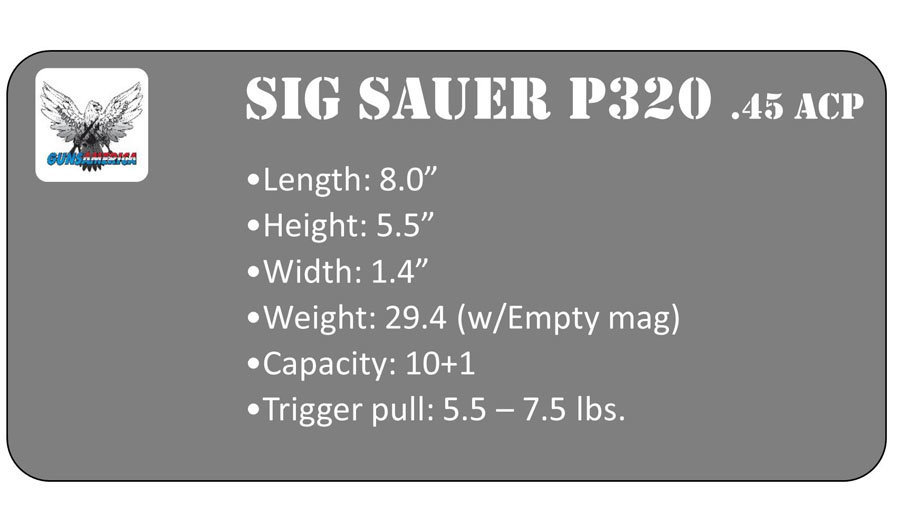
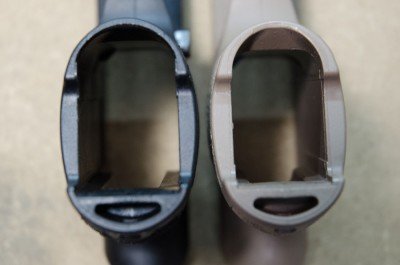
The first thing I did when I got the P320 .45 on my work bench was pull a 9mm version apart and try mixing parts. Everything looks promising at first – but they do not interchange. The reasons, as I’m able to observe, are two: First and foremost it is a magazine size issue. 9mm, .40 S&W, and .357 Sig can all fit into a magazine of identical box dimensions. The .45 ACP cannot. The box of the .45 magazine is both wider and deeper to accommodate the bulky cartridge, and therefore requires a specially molded grip module. Reason two is the ejector.
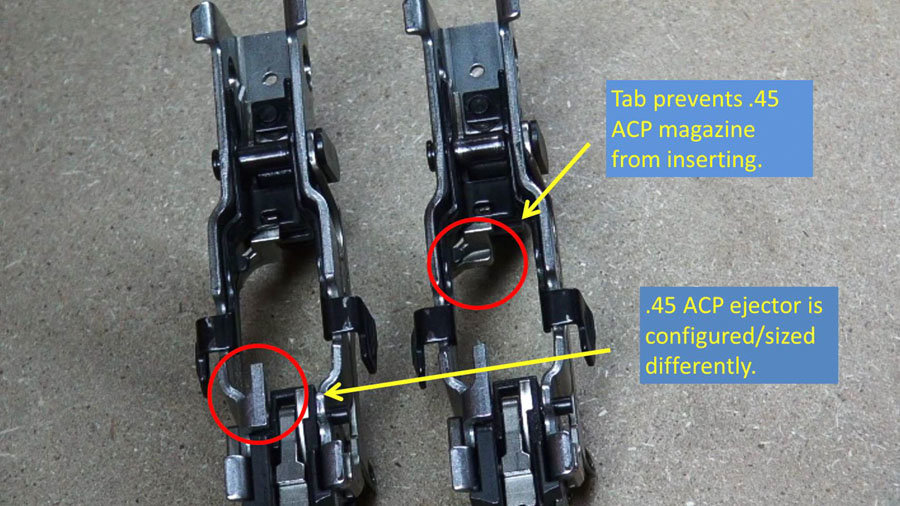
The only functional difference I could see between the smaller
caliber chassis and the .45 chassis is the fact that the latter uses a
shorter ejector. Not surprising, once I realized it. I have no doubt
that there would be malfunctions if that were not so. The chassis for
non-.45 calibers also includes a metal tab to prevent the .45 magazine
from being loaded in. For all intents and purposes then, the .45 Auto
variety of the P320 family stands alone. There is still the good news
that you can eventually have several sizes (four, if they follow the
Full, Compact, Carry, and Subcompact offerings) in .45 ACP that use just
one serialized chassis.
Like its smaller caliber siblings, the P320 .45 comes with two magazines and a convenient (and actually quite good) polymer paddle holster. The full sized magazine for the full sized grip panel (what we would call the ‘frame’ of any other pistol) holds 10 rounds. This puts it on par with the majority of .45 autos, but comes up short of several models offered by Glock, Springfield Armory, and others. Never is the “Size vs. Capacity” argument so relevant as with the massive .45 Auto cartridge. I don’t mind 10+1 and I think it allows for a “just right” sized pistol stock.
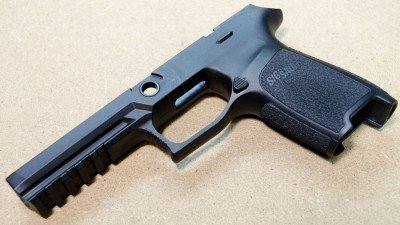
My copy of the P320 came equipped with the optional SIGLITE® night
sights. The standard sights are 3-dot contrast. That is the only
optional choice with the P320 line, except for some marketing driven
color options for the grip modules such as flat dark earth (FDE). Night
sights raise the price of the gun, but the various color offerings
generally do not. Fit and finish is typical Sig Sauer. In other words,
excellent. One may be tempted to poo-poo the look and feel of the dull
poly lower on these guns, but remember – Sig does not consider these a
permanent part of your firearm and replacements are $46 as of this
writing.
That said, the design of the grip module is fantastic from an ergonomics and practical perspective. The look is pure Sig, and your hand feels right at home wrapped around it. The grips are available in three hand sizes for each module size for each caliber. Scratching your head yet? Okay, it works like this: For each caliber offered, the P320 is (or will be) available in Full size, Compact, Carry, and Subcompact. Then, each of those sizes can be had in small, medium, or large. That’s twelve permutations of each caliber P320! And that’s not considering the fancy colors like FDE. Essentially, the S,M,L sizing changes only the circumference and reach aspects of the grip surface, making them thinner or thicker in the handle. The length and height don’t change. Each grip module has molded-in grip texture that is very akin to the modern E2 style grips on newer Sig pistols. I like this texture and find it very effective.
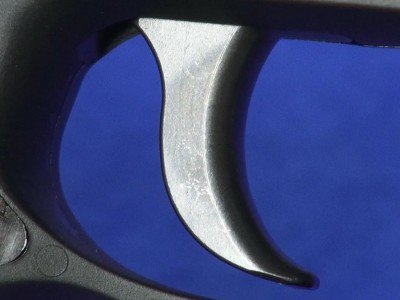
What made me fall in love with the P320 though, was the trigger. I
was pleased to see that Sig did not follow the crowd when it comes to
striker-fired triggers, but instead made the P320’s bang switch out of
steel and left it smooth faced and thick. It has a Sig shape and feel.
But most of all what it has is an incredibly crisp break and reset. I
was hoping that the .45 version would be just as good as the 9mm and .40
that I’m accustomed to. Sig specs the trigger pull at between 5.5 and
7.5 lbs. My measured average tipped the scale at just under 7 lbs. But I
have often opined that the weight of the trigger is far less important
to a good shooting experience than the cleanness of travel and crispness
of break. And because both those elements are superb on the P320, the
feel of the trigger is much lighter than those numbers suggest.
Sig Sauer supplies the P320 pistols with two magazines and a polymer paddle holster. Before you scoff at the “free holster”, I’ll tell you that it’s a pretty good one. Of course it fits your new Sig perfectly, and it’s sturdy and very practical. I’d be happy to wear it out before I felt the need for a new one – even if this were to be a competition gun. The magazines hold 10 rounds, and are manufactured by Mec-Gar in Italy. They functioned flawlessly in all my testing – as did the pistol. Not a single malfunction of any kind after nearly a half-case of Remington UMC, some Winchester, Federal, Freedom Munitions, and steel cased Tul Ammo. I even fed it a whole box of my handloads for good measure. Everything feeds, fires, and ejects without a hitch.
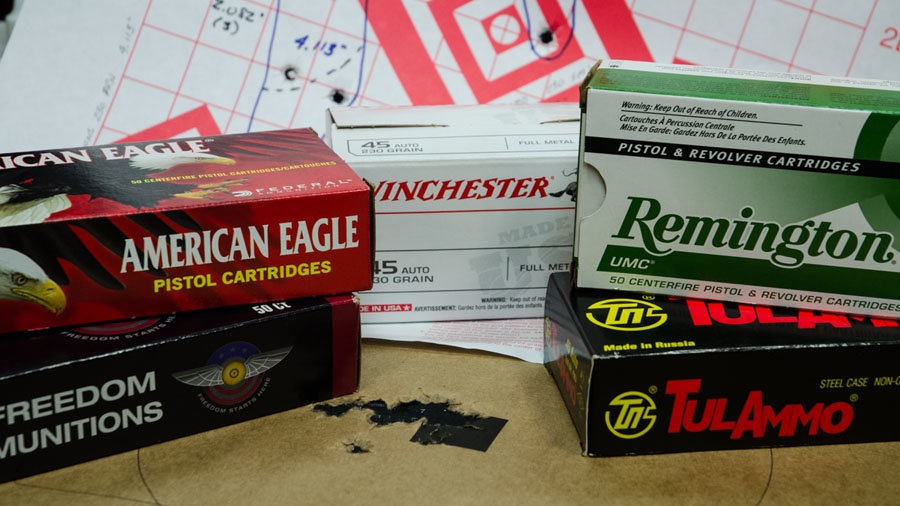
I did some 25-yard accuracy tests, rested on a bag. The results were good overall, with a pretty wide spread between best and worst. The P320 seemed to like the Remington UMC the best, followed closely by Winchester white box.
Looks like we’ve got a blue collar gun here that likes to shoot what you can find at the local discount store. I shot five-shot groups, and then from those I also chose a “Best Three” subgroup. The best performance was a three shot group from Remington at just under 1 inch.
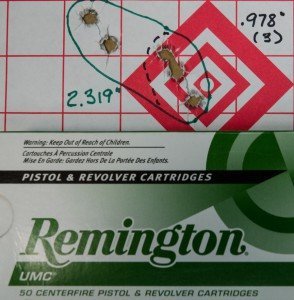
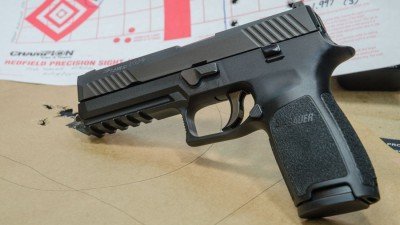
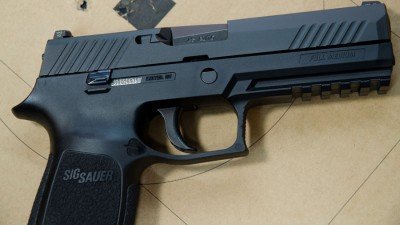
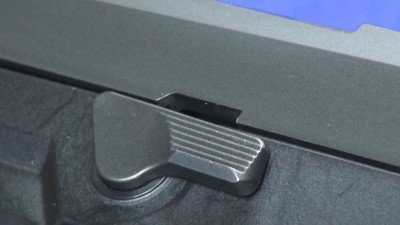
Controls are sparse, well placed, and function very well. The slide
stop/release levers appear on both sides of the pistol for all P320’s.
It’s not as high quality as you may be accustomed to on a Sig, but it’s
part of the removable chassis and had to be designed for universal fit.
Easy to reach without altering one’s grip, it operates just fine. The
triangular and aggressively grooved magazine release is one of the best
I’ve used. The button is large and easy to depress. You don’t feel like
there is an automobile suspension spring behind it. Magazine ejection is
clean, fast, and very positive. The control is reversible for lefties.
The only remaining control you’ll find out the outside of the pistol is
the one that bugs me. It’s the takedown lever, and in my opinion it is
far too large – mainly in the thickness department. It adds about 1/8”
to the thickness of the pistol. Not a big deal maybe on the full sized
frame – but a very big deal on a subcompact. The takedown lever is part
of the serialized chassis – and moves with it from module to module if
you buy kits. It also interferes with the thumbs forward shooting grip –
sitting right where your thumb wants to be. Sure, I can move my thumb
under it, and I do (or it takes a beating), but I have to think about it
every time I grip the pistol. Maybe there is an engineering reason for
the mass of this lever, but if not I would like to see that thing put on
a serious diet. Someone at Sig needs to talk to someone at Springfield
Armory – they’ve got this figured out.
The trigger guard is square and large with serrations on its flat front for those who use that as a finger-hold. The magazine fits flush to the grip frame and does not protrude on any side. There is a tabbed area on either side of the grip to allow grabbing and assisting the magazine’s exit, should that ever be necessary. The grip is finished off with a lanyard ring at the heel.
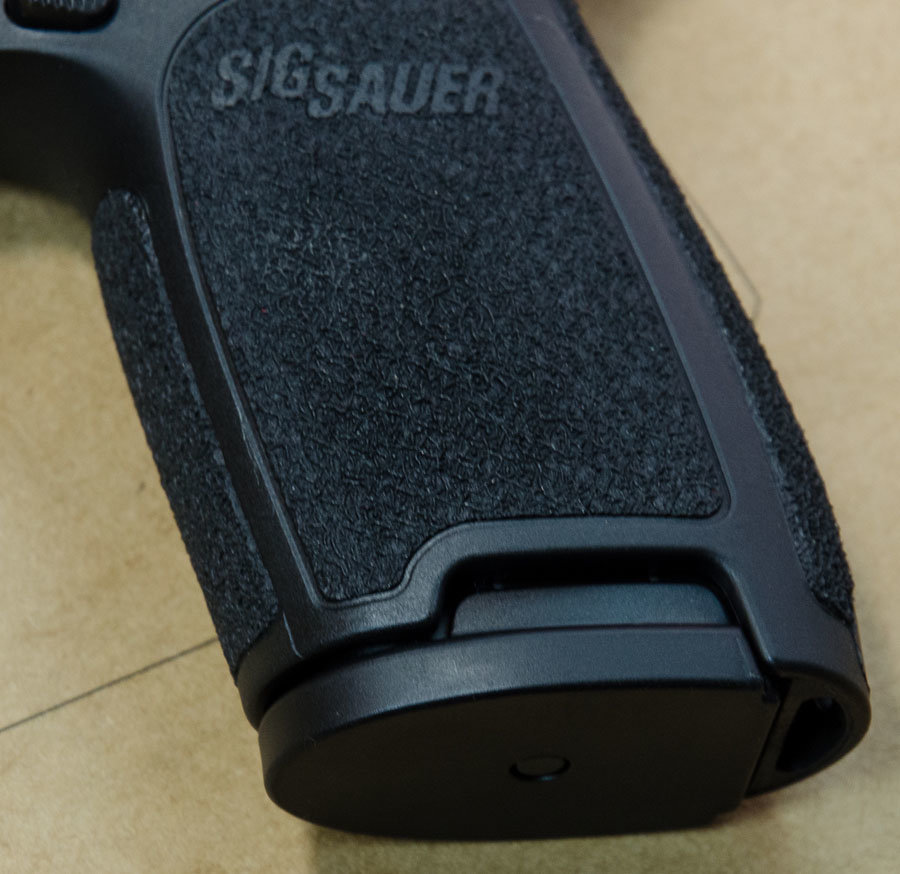
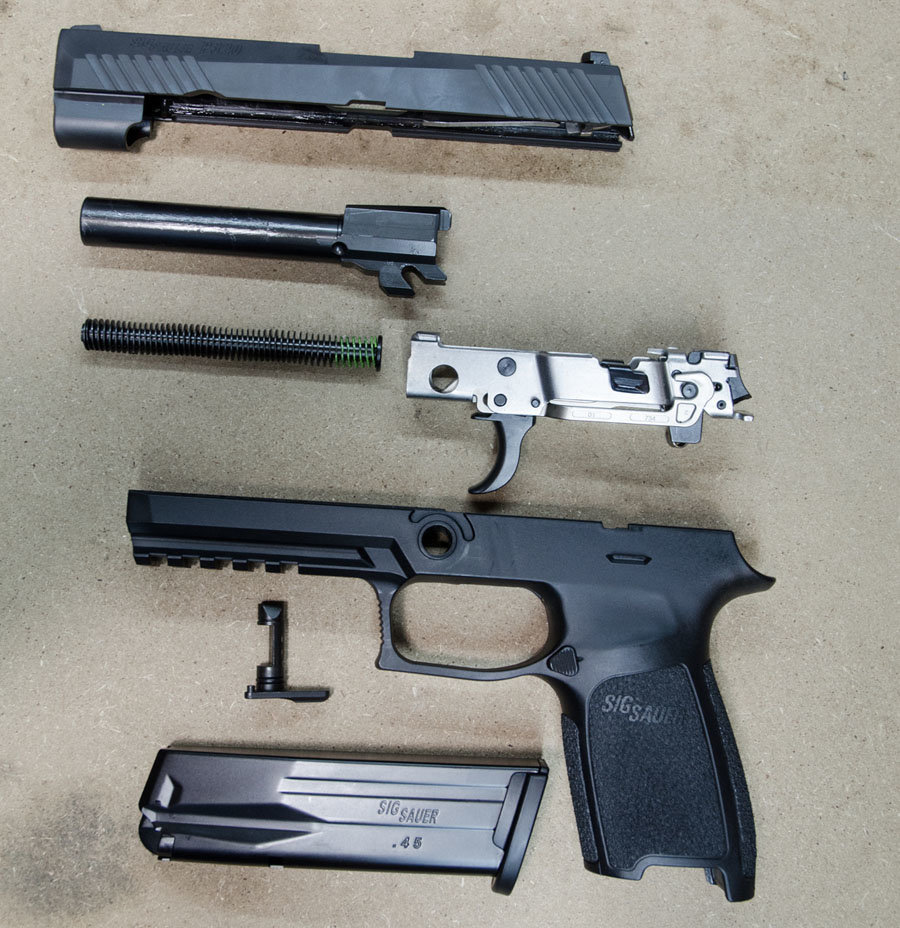
The entire line of P320’s is just a year old, and the .45 ACP is
still so new that Sig Sauer still lists it as “coming soon” on their
website. How it will fare over the long haul is still a question to be
answered. Whether or not LE agencies will adopt it as a duty gun or full
service platform remains to be seen. But as I said up front, I’m a fan
of the design concept and I think can become a proven warrior. Where I
think Sig stands to hurt itself with the P320 line is in the accessories
and kits department. Exchange kits are still hard to obtain, and Sig
has recently raised the price of them significantly (about one third!).
If you cannot get a grip module or caliber conversion you want, or have
to pay nearly the price of a whole new pistol for it, there isn’t a lot
of value in the concept. Let’s hope that they find a price point that
works for them and us – and that they fill the shelves soon.
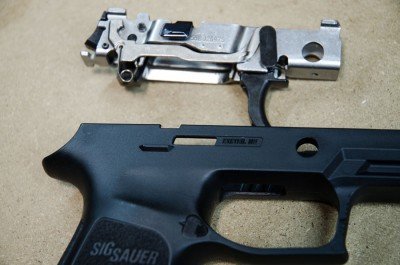
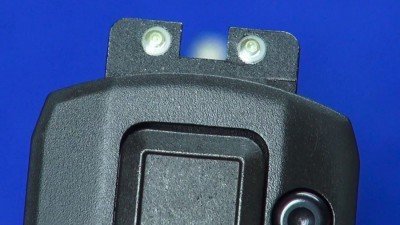
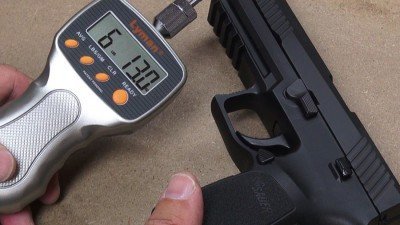
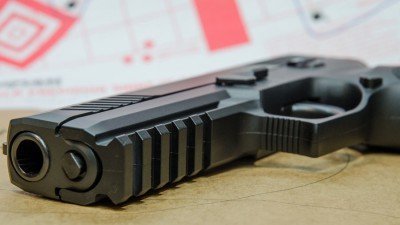
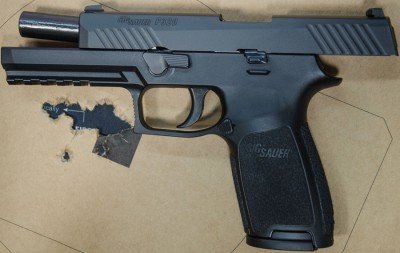
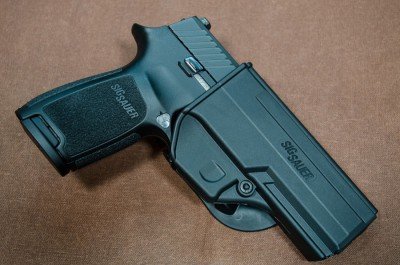
When the SIG SAUER P320 was introduced, it was met with cautious optimism. After all, the P250 platform that first introduced the polymer framed, modular component concept at SIG didn’t exactly set the world on fire. But then few innovations really do take off on their first flight. The Wright brothers made several piles of scrap in their field before making history. The P320 is a striker-fired, rather than hammer-fired platform that uses an internal chassis or fire control group as the serialized gun (SIG calls this the “frame” to make things really confusing) – everything else is just “parts” and not a firearm. If this is all old news to you, then you’ve seen it before. The P320 series has been out for a while now – about a year. But not in .45 ACP – until now. Initially expected in the early spring of 2015, it has been slow in coming for those of us who love the P320 and love 230 grain projectiles.
I do admit without shame that I am a fan of the Sig Sauer P320. The consistency of the platform is very impressive, as is the ability to quickly re-purpose your firearm from a subcompact 9mm to a full sized .40 or .357 Sig in mere seconds. It’s like Transformers for gun geeks! But I remember thinking, as I lifted the first 9mm P320 that I fired, “boy, I really wish this was a .45!”. I don’t know why it is, among many gun-folk, that a handgun somehow becomes more legitimized when offered in .45 ACP. But as long as I’m confessing, I will also admit that I buy into it too.


One reason .45 ACP is not a mix-and-match with other calibers is the magazine size, and magwell difference.
Modularity and Compatibility
And then there is the issue of compatibility with other P320’s. It’s not. So let’s start right off with the disappointing part. By compatible I mean the ability to remove the chassis from a .45 and insert it into the kit (grip frame, side, barrel, etc.) of a 9mm, .40 S&W, or .357 Sig. With no official information that I could find, I was left scratching my head as to why that might be – and more importantly, why Sig would devalue the product line that way. After all, the pressures of the .40 and .357 are greater than the .45… so maybe it was a cartridge diameter issue.The first thing I did when I got the P320 .45 on my work bench was pull a 9mm version apart and try mixing parts. Everything looks promising at first – but they do not interchange. The reasons, as I’m able to observe, are two: First and foremost it is a magazine size issue. 9mm, .40 S&W, and .357 Sig can all fit into a magazine of identical box dimensions. The .45 ACP cannot. The box of the .45 magazine is both wider and deeper to accommodate the bulky cartridge, and therefore requires a specially molded grip module. Reason two is the ejector.

The
other reason is the ejector size and geometry, which is unique for the
.45. A preventative tab is present on the smaller calibers to prevent
use with .45 Auto.
Like its smaller caliber siblings, the P320 .45 comes with two magazines and a convenient (and actually quite good) polymer paddle holster. The full sized magazine for the full sized grip panel (what we would call the ‘frame’ of any other pistol) holds 10 rounds. This puts it on par with the majority of .45 autos, but comes up short of several models offered by Glock, Springfield Armory, and others. Never is the “Size vs. Capacity” argument so relevant as with the massive .45 Auto cartridge. I don’t mind 10+1 and I think it allows for a “just right” sized pistol stock.

Grip
frames are a replaceable commodity with the P320. This is the full
size, medium grip. With five grooves of picatinny rail out front and E2
style texture, it provides a stable base for the gun.
That said, the design of the grip module is fantastic from an ergonomics and practical perspective. The look is pure Sig, and your hand feels right at home wrapped around it. The grips are available in three hand sizes for each module size for each caliber. Scratching your head yet? Okay, it works like this: For each caliber offered, the P320 is (or will be) available in Full size, Compact, Carry, and Subcompact. Then, each of those sizes can be had in small, medium, or large. That’s twelve permutations of each caliber P320! And that’s not considering the fancy colors like FDE. Essentially, the S,M,L sizing changes only the circumference and reach aspects of the grip surface, making them thinner or thicker in the handle. The length and height don’t change. Each grip module has molded-in grip texture that is very akin to the modern E2 style grips on newer Sig pistols. I like this texture and find it very effective.

The trigger on the P320s is pure SIG SAUER. No compromises here.
Sig Sauer supplies the P320 pistols with two magazines and a polymer paddle holster. Before you scoff at the “free holster”, I’ll tell you that it’s a pretty good one. Of course it fits your new Sig perfectly, and it’s sturdy and very practical. I’d be happy to wear it out before I felt the need for a new one – even if this were to be a competition gun. The magazines hold 10 rounds, and are manufactured by Mec-Gar in Italy. They functioned flawlessly in all my testing – as did the pistol. Not a single malfunction of any kind after nearly a half-case of Remington UMC, some Winchester, Federal, Freedom Munitions, and steel cased Tul Ammo. I even fed it a whole box of my handloads for good measure. Everything feeds, fires, and ejects without a hitch.
Sig Sauer P320 .45 ACP Fullsize

The P320/.45 was put through its paces with several types of ammo.
| 25 Yard Results – Rested | |||
| Ammunition Brand | Ammunition Type | 5-Shot Group | 3-Shot Group |
| Winchester White Box | 230 gr. FMJ | 2.382 | 1.050 |
| Remington UMC | 230 gr. FMJ | 2.319 | 0.978 |
| Federal American Eagle | 230 gr. FMJ | 4.535 | 1.997 |
| Freedom Munitions | 230 gr. FMJ | 4.113 | 2.082 |
| TulAmmo | 230 gr. FMJ | 4.264 | 1.660 |
I did some 25-yard accuracy tests, rested on a bag. The results were good overall, with a pretty wide spread between best and worst. The P320 seemed to like the Remington UMC the best, followed closely by Winchester white box.
Looks like we’ve got a blue collar gun here that likes to shoot what you can find at the local discount store. I shot five-shot groups, and then from those I also chose a “Best Three” subgroup. The best performance was a three shot group from Remington at just under 1 inch.

Just edging out the Winchester, the best groups were achieved with Remington UMC 230 grain ball.

The SIG SAUER P320 takes its design inspiration from the X-Five line, making it one sharp looking handgun.

Most P320s ship with the Medium sized grip module, but are available in Large and Small too.
Form and Function
If you like Sigs, you’ll find the feel of this gun in your hand to be a familiar one. Yet, though both are double-stack .45’s, it is thinner than the Sig Sauer P227 because it is a one-piece molded grip body that needn’t be any larger than necessary. On this molded grip, Sig has placed texturing very nearly identical to the E2 grips on their new handguns. I like this texture and feel it does a great job of providing superior grip without the discomfort of some more aggressive styles. You’ll understand just how good that grip texture is, when you see the skin embedded in it after a shooting session. I hear it’s great for removing callouses, too. The beavertail on the P320 full sized frame is a generous one. It gives the web of the hand a comfortable and secure place to wedge itself and aids in the stability of the pistol during recoil. Opposite that is a nicely undercut trigger guard. My smallish hands find the reach to the trigger to be just about ideal with the medium module (which is the most common one shipped for stock orders).
The author’s only pet peeve with the P320 is the over-sized takedown lever.
The trigger guard is square and large with serrations on its flat front for those who use that as a finger-hold. The magazine fits flush to the grip frame and does not protrude on any side. There is a tabbed area on either side of the grip to allow grabbing and assisting the magazine’s exit, should that ever be necessary. The grip is finished off with a lanyard ring at the heel.

Magazine
fit is perfection. Perfectly flush on every side with finger tabs in
the unlikely event that assisted removal is necessary.
The Gun Parts
The important parts of the P320, aside from the removable chassis (or FCU) are all up top. The slide is stainless steel coated with Sig’s impervious Nitron® finish. The 4.7” barrel is typical Sig Sauer and its coating is nearly impossible to mar or scratch with normal use. It sits atop a dual captured recoil spring and guide rod assembly made of steel. A nicely milled and polished breech face and short external extractor finish it off. Taking its design cues from the X-Five series of pistols, the side presents a ruggedly beautiful aesthetic, with its geometric angles and cuts, and large forward serrations.
Every
field strip can easily be a detail strip by removing the FCU. It adds
only seconds to the process and allows you to inspect and clean every
part.

Removable serialized chassis/frame/FCU = gun (top). Gun-shaped polymer parts and slide assembly – not a gun.

Tritium
powered SIGLITE ® night sights are optional, but are among the best
factory-installed night sights because they also provide great daytime
visibility.

The trigger might measure a tad on the heavy side, but it’s so smooth and crisp that you won’t believe the numbers.

It’s nice to see that full-sized bore on a full-sized gun!

The author got almost all of these 20 rounds in one ragged hole at 10 yards offhand.

The included paddle holster is not just ‘okay’, it’s quite good.
No comments:
Post a Comment